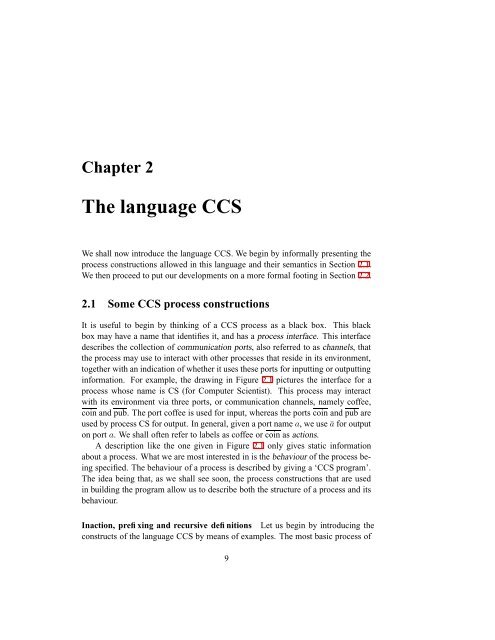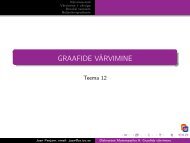Reactive Systems: Modelling, Specification and Verification - Cs.ioc.ee
Reactive Systems: Modelling, Specification and Verification - Cs.ioc.ee
Reactive Systems: Modelling, Specification and Verification - Cs.ioc.ee
You also want an ePaper? Increase the reach of your titles
YUMPU automatically turns print PDFs into web optimized ePapers that Google loves.
Chapter 2<br />
The language CCS<br />
We shall now introduce the language CCS. We begin by informally presenting the<br />
process constructions allowed in this language <strong>and</strong> their semantics in Section 2.1.<br />
We then proc<strong>ee</strong>d to put our developments on a more formal footing in Section 2.2.<br />
2.1 Some CCS process constructions<br />
It is useful to begin by thinking of a CCS process as a black box. This black<br />
box may have a name that identifies it, <strong>and</strong> has a process interface. This interface<br />
describes the collection of communication ports, also referred to as channels, that<br />
the process may use to interact with other processes that reside in its environment,<br />
together with an indication of whether it uses these ports for inputting or outputting<br />
information. For example, the drawing in Figure 2.1 pictures the interface for a<br />
process whose name is CS (for Computer Scientist). This process may interact<br />
with its environment via thr<strong>ee</strong> ports, or communication channels, namely coff<strong>ee</strong>,<br />
coin <strong>and</strong> pub. The port coff<strong>ee</strong> is used for input, whereas the ports coin <strong>and</strong> pub are<br />
used by process CS for output. In general, given a port name a, we use ā for output<br />
on port a. We shall often refer to labels as coff<strong>ee</strong> or coin as actions.<br />
A description like the one given in Figure 2.1 only gives static information<br />
about a process. What we are most interested in is the behaviour of the process being<br />
specified. The behaviour of a process is described by giving a ‘CCS program’.<br />
The idea being that, as we shall s<strong>ee</strong> soon, the process constructions that are used<br />
in building the program allow us to describe both the structure of a process <strong>and</strong> its<br />
behaviour.<br />
Inaction, prefixing <strong>and</strong> recursive definitions Let us begin by introducing the<br />
constructs of the language CCS by means of examples. The most basic process of<br />
9
















